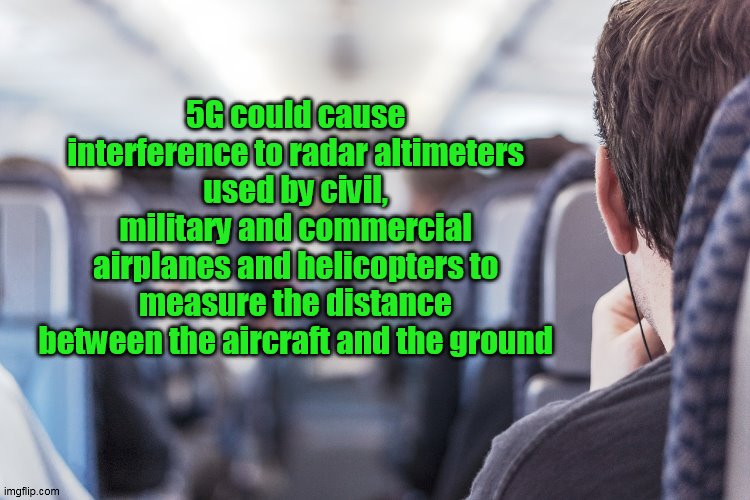 By B.N. Frank
By B.N. Frank
American opposition to 5G technology has been ongoing for years due to various significant risks associated with it. In December 2021, AT&T and Verizon agreed to delay expansion until January 5 due to warnings about aviation safety risks (see 1, 2). Airlines, the Federal Aviation Association (FAA), and transportation secretary, Pete Buttigieg still asked for more time, however, the telecoms rejected that request until January 3 when they agreed to an additional 2 week delay. Now the FAA has announced that some airports will have 5G C-Band buffer zones to reduce risks.
From RCR Wireless:
FAA publishes list of airports that will have C Band buffer zones
In December, AT&T and Verizon agreed to pause their C Band plans following warnings issued by the FAA that the 5G spectrum could interfere with aviation safety systems
50 U.S. airports have been given 5G buffer zones per an agreement between the Federal Aviation Administration (FAA) and AT&T and Verizon. Following some back and forth between the two parties, the list of airports was published on Friday, and includes major airports in Indianapolis, northern New Jersey, New York City, Austin, Nashville, Houston and Los Angeles, among many others.
In December, AT&T and Verizon agreed to pause their C Band plans until early January following warnings issued by the Federal Aviation Administration (FAA) that the 5G spectrum could interfere with aviation safety systems, particularly during low-altitude flight operations.
When the FAA Chief Steve Dickson and U.S. Transportation Secretary Pete Buttigieg asked Verizon and AT&T to delay their C Band roll out for an additional two weeks, the carriers first rejected the new request. In a joint letter, the carriers’ CEOs called the proposal “an irresponsible abdication of the operating control required to deploy world-class and globally competitive communications networks.”
The pair changed their tune the following day, however, ultimately agreeing to the two-week delay. Reuters reported that the delay came in the face of pressure from the White House, aviation unions and a threat by airlines to file suit that would have blocked C Band deployments until the issue was resolved in court.
Reuters also cited an email from Verizon CEO Hans Vestberg to employees which said that the company sees no aviation safety issue with 5G, but said the FAA “intended to disrupt an already difficult time for air travel if we move ahead with our planned activation… We felt that it was the right thing to do for the flying public, which includes our customers and all of us, to give the FAA a little time to work out its issues with the aviation community.”
Chosen based on several factors, including traffic volume, the number of low-visibility days and geographic location, the buffer zones are currently set to last six months. According to the FAA and the aviation community, the 5G-free zones will limit the potential interference of 5G antennas with airplane instruments, called radar altimeters, that tell pilots how far they are from the ground. Such instruments are particularly critical when visibility is poor, such as during bad weather.
Of course, there are other considerable risks associated with 5G technology as well including
- Cybersecurity risks (see 1, 2, 3, 4)
- Environmental risks (see 1, 2, 3, 4, 5, 6)
- Health risks (see 1, 2, 3, 4, 5)
- Privacy risks (see 1, 2, 3)
- Weather forecasting satellite interference risks
- Utility infrastructure interference risks
Studies have also determined that 4G is still better, more reliable, and safer than 5G (see 1, 2, 3, 4, 5, 6, 7).
Nevertheless, last week T-Mobile announced the company would also be expanding its 5G coverage (which is not on the C-band) throughout the U.S.
Of course, opposition and warnings have slowed and/or stopped 5G deployment in some places. Since 2017 doctors and scientists have asked for moratoriums on Earth and in space (see 1, 2) and the majority of scientists oppose deployment. Since 2018 there have been reports of people and animals experiencing symptoms and illnesses after 5G was activated (see 1. 2, 3, 4). Some blame COVID-19 on 5G deployment while others do not. Regardless, research has determined that there are health risks associated with 5G exposure as well as exposure to 4G and other sources of wireless Wi-Fi radiation (see 1, 2) and Electromagnetic Fields (aka “Electrosmog”).
Activist Post reports regularly about 5G and other unsafe technology. For more information visit our archives and the following websites.
- Americans for Responsible Technology
- 5GFree
- 5G Information
- WhatIs5G.info
- 5G Space Appeal
- Stop 5G International
- Wireless Information Network
- Electromagnetic Radiation Safety
- Environmental Health Trust
- Physicians for Safe Technology
- Scientists4WiredTech
Become a Patron!
Or support us at SubscribeStar
Donate cryptocurrency HERE
Subscribe to Activist Post for truth, peace, and freedom news. Follow us on Telegram, HIVE, Flote, Minds, MeWe, Twitter, Gab and What Really Happened and GETTR.
Provide, Protect and Profit from what’s coming! Get a free issue of Counter Markets today.

Be the first to comment on "Some U.S. Airports Will Have 5G C-Band “Buffer Zones” Says FAA"